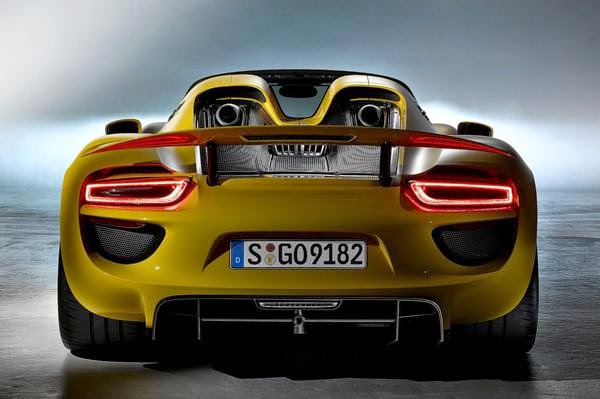Porsche working on Ferrari 458 rival.
Porsche is working on a new family of supercars. The line-up will include a four-cylinder turbocharged version of the Boxster and a new eight-cylinder supercar which, when on road, will rival the Ferrari 458.
The flagship model is still unnamed and is thought to be carrying the development tag ‘988’. The development will finally serve to put to rest concerns of many Porsche engineers that the company cannot compete with eight-cylinder Ferraris with the classic six-cylinder engine used in the 911.
While there is no indication about the shape of the 900 model yet, it is likely to follow styling and detailing of the 918 hypercar. Headlights like the 918, expect a long rear deck too, because of the mid-mounted flat eight engine.
The recent engine failures that stopped production of the new 3.8-litre 011 GT-3 are being seen by some in the company as proof that the flat six has reached the end of its natural life in terms of increasing its cubic capacity. Some years ago, Porsche engineers told our sister publication Autocar UK that the “theoretical limit” for a flat six engine was “around 4.2 litres… after that, the weight of some internal components gets too great [for ideal balance]”.
Switching to a flat eight layout – expected to be sized at about 4.0 litres – will give Porsche the headroom to extract plenty of extra power for its flagship model, should it wish to, with various strengths of turbocharging. It’s thought that the prototype engine is being tested with four turbos to push the output towards 600bhp – more than the 562bhp of today’s Ferrari 458 Italia, with more torque (likely to be above 55kgm) available much lower down the rev range.
As Porsche pushes towards a medium-term sales target of 200,000 cars per year, the firm has also laid plans for a new architecture that will be used as the basis for all of its upcoming sports cars – mid-engined and rear-engined – and could also underpin the next-generation Lamborghini Aventador.
Porsche is also developing a brand-new family of turbocharged and normally aspirated boxer engines, which will come in four, six and eight-cylinder formats. The new engine family will generate much higher power densities and feature some innovative fuel-saving tech.
Sources indicate that the new architecture will come with the option of both mechanical and combined hybrid/electric all-wheel drive, the latter using an electrically driven front axle similar to that of the 918 Spyder.
Porsche’s eight-cylinder supercar is expected to go on sale in 2017 in the international markets, closely followed by replacements for the Boxster, Cayman and 911. The entry-level Boxster and Cayman are expected to have a 2.0-litre turbocharged flat four good for about 280bhp, with hotter versions set to have up to 350bhp. By 2019, Porsche should have moved its entire sports car family to the new architecture and next-gen engines. But the structure and components underpinning the new sports car models cannot be strictly called a platform. That’s because of the wide variation of requirements for a family of cars that will stretch from a 280bhp four-cylinder entry-level model to a new range-topping model with about 600bhp. The front-end architecture and crash structure and the central passenger cell will be mostly the same on all the new models. But there will be considerable room for specification differences. For example, the front suspension and steering assembly are likely to come in different versions. There will be one for the lower-powered Boxster, Cayman and 911 models. There will also be a mechanical all-wheel-drive version and one with electric drive to the front wheels.
The modular engineering principle has also been applied to the design of the chassis’ front end, so it will accommodate upgraded spring and dampers systems and a wider range of brake set-ups, depending on which model is being underpinned.
The same goes for the new structure. Porsche is thought to be switching to a construction technique that uses aerospace bonding, riveting and welding to enable the basic sports car architecture to be upgraded with lightweight materials.
Just as the Lamborghini Huracan uses a carbonfibre rear bulkhead and centre tunnel within an aluminium structure, Porsche’s new architecture is expected to be upgraded with aluminium and composite structural elements for the 988. As for the number of body styles, the architecture is remarkably flexible. Aside from different engine locations and sizes, it is also ‘package protected’ for fixed-head, cabriolet and targa styles.
The building blocks for Porsche's new sports cars
1 Three different front axles
Porsche's new sports car architecture is thought to accommodate three different front axles. Two will send drive to the front wheels, one mechanically and one via electric motors. The hybrid axle can also be used to enhance handling by momentary activation of the electric motor to help the car steer into and accelerate out of bends.
2 Shared front structures
The front crash structure, bulkhead and central floorpan are thought to be common to all the future boxer-engined sports cars. The 988’s structure is likely to be enhanced by composite materials such carbonfibre-reinforced plastic. In this, it will be similar to the Lamborghini Huracán, which has a ‘monolithic’ carbonfibre centre tunnel and rear bulkhead to increase rigidity significantly.
3 New family of ‘ideally sized’ engines
The 988’s new flat eight is part of an all-new family of boxer engines that is expected to use new low-friction technology and ‘ideally sized’ cylinders, which are expected to measure about 500cc each. Turbocharging on all engines will also improve economy.
4 At least two separate rear ends
The new sports car family’s rear structure will come in at least two variations to accommodate the different engine and transmission lengths but, more significant, because there will be three mid-engined layouts (with four, six and eight-cylinder engines) and the 911’s traditional six-cylinder, rear-engined layout.




Comments
Post a Comment